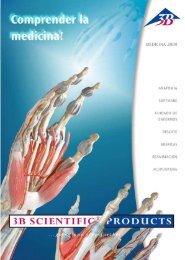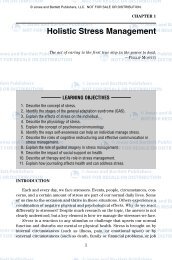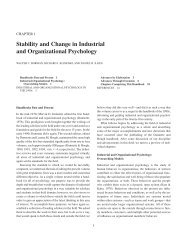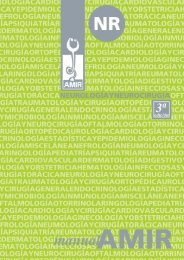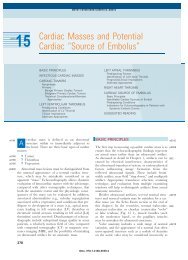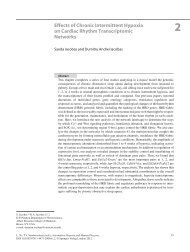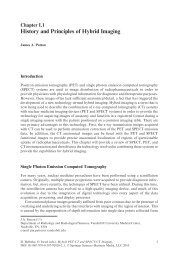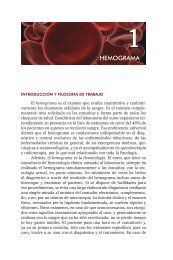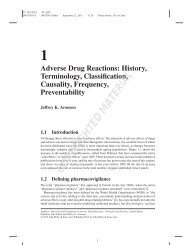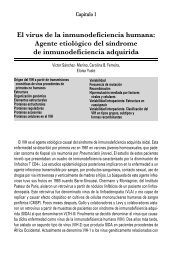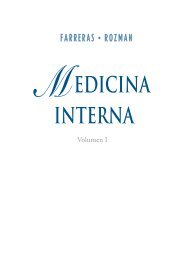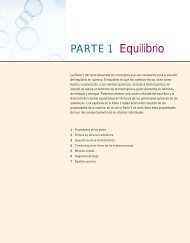Download Sample pages 1 (pdf, 195 kB) - Springer
Download Sample pages 1 (pdf, 195 kB) - Springer
Download Sample pages 1 (pdf, 195 kB) - Springer
You also want an ePaper? Increase the reach of your titles
YUMPU automatically turns print PDFs into web optimized ePapers that Google loves.
Chapter 2<br />
Pain and Intercultural Communication<br />
James Hallenbeck<br />
Introduction<br />
Pain is a universal experience, suffered in isolation. At the most basic level, pain serves a useful<br />
function in alerting organisms to threats to bodily integrity. In more advanced, social animals such<br />
as chimpanzees, communication regarding pain may enhance the chance for survival as others are<br />
enlisted in defense and support of the individual. In humans, communication obviously takes on far<br />
greater levels of complexity as potential responses to communicated pain are so varied and nuanced.<br />
Still, at its core communication about pain is driven by the need for assistance from others.<br />
In this chapter, we will examine communication about chronic pain through the lens of intercultural<br />
communication. Intercultural communication as a fi eld offers a useful perspective that may<br />
heighten awareness of common pitfalls that frequently give rise to miscommunication. I will then<br />
suggest some strategies that should minimize the risk or severity of miscommunication in the context<br />
of pain.<br />
Much of the literature about pain communication, including work on survey instruments and pain<br />
scales, has focused on trying to determine pain severity, the qualitative characteristics of pain, and at<br />
times the veracity of pain complaints. Driving this literature is an understandable desire to characterize<br />
the underlying physiology giving rise to a pain complaint, so that therapy can most appropriately<br />
and effectively be delivered. Cross-cultural work in this vein often seeks to determine the transferability<br />
of survey instruments among cultural groups (Gaston-Johansson et al. 1990 ; Zatzick and<br />
Dimsdale 1990 ; Thomas and Rose 1991 ; Cleeland and Ryan 1994 ; Chaudakshetrin et al. 2007 ) . This<br />
is admirable and necessary, but efforts in this vein fall short in a most basic way. Such approaches<br />
tend to perceive language and culture as barriers or veils, which must be broached in order to locate<br />
an underlying biologic reality (Cleeland and Ryan 1994 ) . While this may be reasonable at a certain<br />
level of physiology, such reductionism neglects the fact that pain as an experience is inexorably<br />
interwoven with culture and that for humans language is essential in giving voice to such experience<br />
(Pugh 1991 ; Im et al. 2009 ; Schiavenato and Craig 2010 ) .<br />
Cross-cultural misunderstandings can indeed obscure formal medical diagnoses. However, it is<br />
also true is that any episode of communication about pain represents its own truth within a cultural<br />
context and such truth is correlated with but independent of biologic reality (Fruend 1990 ; Trnka 2007 ) .<br />
J. Hallenbeck , MD (*)<br />
Division of General Medical Disciplines, Department of Medicine ,<br />
Stanford University School of Medicine , Stanford , CA , USA<br />
VA Palo Alto Health Care Services , Palo Alto , CA , USA<br />
R.J. Moore (ed.), Handbook of Pain and Palliative Care: Biobehavioral Approaches for the Life Course,<br />
DOI 10.1007/978-1-4419-1651-8_2, © <strong>Springer</strong> Science+Business Media, LLC 2012<br />
19
20 J. Hallenbeck<br />
This truth usually represents in part a request for some response from others within the context of a<br />
particular relationship in a particular culture. The response may be behavioral, the administration of<br />
some aid or medication, or relational, as through a demonstration of empathy (Goubert et al. 2005 ) .<br />
For example, if a person with a history of substance abuse purposely lies about pain with a goal of<br />
getting some drug, there certainly is a problem in the episode of communication in terms of biologic<br />
veracity. However, the communication is still “truthful” or at least real in terms of being a request<br />
from one person to another for a desired response. Such a request is made in the context of a social<br />
and regulatory system that gives access to such drugs to a select few.<br />
The emphasis in many survey instruments on severity of pain and its biologic origin is itself a<br />
cultural construct of biomedicine, which prioritizes physiologic causality over more social aspects<br />
of experience (Hahn 1995 , Kleinman 1995 ; Fabrega 1997 ; Hallenbeck 2007 ) . In any such instrument,<br />
particular aspects of pain communication are to be elicited to the exclusion of others. Survey<br />
instruments, then, represent a culturally sanctioned form of forced communication, albeit with<br />
benefi cent intent, which may or may not serve the purposes of individuals experiencing pain.<br />
High and Low Context Communication<br />
Intercultural communication is a fi eld of anthropology, fi rst developed by Edward Hall ( 1976, 1983,<br />
1990, 1997 ) . Hall noted that human interactions and related communication can be broadly classifi<br />
ed as being high or low in their cultural context. High context communication embeds large amounts<br />
of meaning within the situation or context within which communication occurs. Where people are<br />
when they are communicating, who is present, and how they position themselves relative to one<br />
another are all parts of the context in which a message is delivered, interpreted, and received. High<br />
context communication is thus relational . That is, a major goal of such communication is to affect<br />
in some way the relationship of those participating in it. Relational goals may include establishment<br />
or clarifi cation of the relationship. They may also relate to a request for some change in behavior or<br />
assistance. In everyday life, courtship behavior such as dating is an example of an inherently high<br />
context encounter. Low context communication, in contrast, is concrete, situation specifi c, and taskoriented<br />
and involves minimal relational work. Such communication is usually straightforward and<br />
relatively unambiguous. Asking for street directions is an example of low context communication.<br />
Hall noted that serious cross-cultural misunderstandings can occur when people using low context<br />
communication styles interact with others using high context communication styles (or where<br />
people using very different high context styles interact with one another). Different ethnic groups<br />
may prefer relatively higher or lower contextual communication styles. Certain groups, most notably<br />
those of Northern European descent, are believed to be relatively lower in contextual style than others,<br />
such as Southern Europeans or Asians (Samovar and Porter 1997 ) . Clashes can occur among<br />
individuals from different ethnic groups, based in part on their differing communication styles in this<br />
regard. However, cross-cultural clashes can also occur within relatively homogenous ethnic groups.<br />
A case in point can be seen commonly in encounters between clinicians, acculturated to the low<br />
context world of biomedicine and the lay public, who tend to experience sickness as relational, high<br />
context events, regardless of ethnicity (Hallenbeck 2006 ; Hallenbeck and Periyakoil 2009 ) . Both<br />
high and low context approaches to sickness make sense within their particular cultural framings.<br />
A scientifi c, physiology-driven understanding of disease allows for a very precise and often effective<br />
optimization of medical therapies. Low context communication includes math, computer, code, and<br />
scientifi c and medical language. It often works better across linguistic groups and cultures precisely<br />
because it avoids complex and confounding meanings associated with ordinary language. For<br />
instance, the use of pain scores as a means of communicating pain severity via mathematical symbols<br />
(1–10) is a low context means of communication, which offers a real advantage in this regard.<br />
A Likert scale between 1 and 10 means pretty much the same thing in all languages and cultural
2 Pain and Intercultural Communication<br />
groups. In contrast, high context communication about sickness also makes sense in that illness<br />
(as opposed to a disease) almost always affects more than one person. Serious illness usually involves<br />
an alteration in the relations among closely linked individuals. The sick person becomes dependent<br />
upon others, clinicians, family members, and caregivers, for a wide range of needs. High and low<br />
context approaches to sickness make sense in their own realms; and ideally these two approaches are<br />
complementary and synergistic. However, at worst, what is risked is people talking past another and<br />
serious miscommunication.<br />
In terms of intercultural communication, pain is a particularly interesting topic. Like all symptoms<br />
pain is by defi nition a subjective phenomenon. The defi nition of pain according to International<br />
Association for the Study of Pain (IASP) suggests the nature of the problem:<br />
Pain has been defi ned as an unpleasant sensory and emotional experience associated with actual or potential<br />
tissue damage, or described in terms of such damage. Note: The inability to communicate verbally does not<br />
negate the possibility that an individual is experiencing pain and is in need of appropriate pain-relieving treatment.<br />
Pain is always subjective ( 2010 ) .<br />
As this quote states, pain is a subjective biopsychosocial experience, which may or may not be<br />
associated with tissue damage. As a symptom, pain is unusual in its variable correlation with objective<br />
reality (tissue damage). By contrast, patients with nausea or dyspnea usually have clear objective<br />
markers associated with their symptoms. The cautionary note regarding communication points<br />
to diffi culties linking subjective experiences with objective reality. One could also add that when<br />
pain has been communicated, it does not necessarily mean that tissue damage has occurred. When<br />
no association with tissue damage is found, what does this mean? Does it mean that such an association<br />
is present, but clinicians have missed it? Is the “unpleasant experience” being described properly<br />
in terms of pain but with no tissue damage? In this instance is the usage of the word pain takes<br />
on metaphoric implications. Or, is the person claiming pain not having an unpleasant experience and<br />
is in effect lying?<br />
Tissue damage suggests the need for a low context approach to healing. The machine is broken<br />
and repairs are in order. Where repair is not possible, a “system override” is needed, where the brain<br />
is told to ignore the blinking red panic light. The subjective and often emotional experience of pain<br />
in contrast cries out for connection with others in hopes of fi nding assistance and relief or, where<br />
relief is inadequate, at least some degree of empathy and understanding and is thus high context<br />
(Biro 2010 ) . Pain, then, is both a high and low context event, requiring both technical and relational<br />
expertise for optimal treatment.<br />
In some conditions, common experience leaves little question as to whether tissue damage has<br />
occurred. Patients with acute and obvious wounds, burns, and broken bones rarely need to convince<br />
others of the severity or veracity of their pain. Cries of anguish and grimacing erupt spontaneously in<br />
such severe pain, even in the absence of another person. The objective reality of trauma and the subjective<br />
cry for help present as one coherent message. However, in many pain states often classifi ed as<br />
chronic pains, there may be little correlation between objective markers of tissue damage and subjective<br />
experience of pain and suffering, even where the associated suffering is every bit as real and great<br />
(Hadjistavropoulos and Craig 1994 ) . Curiously, one would think that it is precisely in such cases that<br />
individuals would want to communicate verbally their distress to others, if for no other reason than to<br />
compensate for the lack of physical stigmata validating their complaints. And yet, clinicians often see<br />
the exact opposite. Patients with chronic pain tend to withdraw. They do not cry out.<br />
Acute and Chronic Pain in Evolutionary Terms<br />
Pain is obviously a fundamental biological property of evolved species that is replete with signifi cant information<br />
regarding the need states of an organism and its capacity for adaptive behavior. It constitutes a hallmark of<br />
sickness and can elicit caring and nurturing. Fabrega ( 1997 , p. 62).<br />
21
22 J. Hallenbeck<br />
Let us consider more closely the puzzle presented by the nature of pain. Why is it that when pain<br />
is most obvious, people scream the loudest and when pain is least obvious, they are often silent?<br />
Such a communication strategy makes sense in evolutionary terms, as highlighted by the experience<br />
of nonhuman, social animals. In calling out with acute injury, a social animal alerts other members<br />
of the herd of an immediate and urgent need for defense and support. Other members of the group<br />
may not only provide defense (e.g., against an attacking animal), but may be able to provide immediate<br />
pain relief (as in taking a thorn out of a foot). Both the vocal and nonverbal communication of<br />
pain and the social response of “sympathetic pain” (feeling pain or discomfort in seeing another<br />
wounded and in pain) appear instinctual and transcultural in their prevalence (Prkachin 1992 ; Otti<br />
et al. 2010 ; Williams 2002 ; Goubert et al. 2005 ; Frith 2009 ) . By way of example, Botvinick and<br />
colleagues demonstrated through magnetic resonance imaging similar patterns of cortical stimulation<br />
in volunteers viewing facial expressions of pain as occurred in them during thermally induced<br />
pain (Botvinick et al. 2005 ) . How then to explain the withdrawal and silence so common in many<br />
chronic pains?<br />
Many pains characterized as “chronic” are in fact better characterized by their representing in fact<br />
or metaphorically certain types of deep tissue pain. Temporal longevity of a pain episode (acute<br />
versus chronic) is variably correlated with this type of pain for which we lack a commonly accepted<br />
word in English. Headaches offer a very good case in point. Most headaches, while temporally of a<br />
short (acute) duration, do not give rise to vocal outbursts, but rather often result in withdrawal and<br />
relative quiet typical of “chronic pain.” Withdrawal in evolutionary terms would be an appropriate<br />
response to bodily damage involving certain deep tissues. In animals and in ancient times for people<br />
the best chance for survival would have been hiding out and waiting for internal healing, if possible,<br />
to occur. Others would be less likely to be of immediate assistance. Indeed, there may have been<br />
some survival benefi t attached to keeping a low profi le. In such situations, communication between<br />
the sick individual and other members of the herd or tribe would be less urgent. Such communication<br />
to the extent it existed would likely transmit the importance of keeping quiet and being less, rather<br />
than more visible.<br />
While primitive people often had little to offer medically to treat conditions giving rise to such<br />
chronic [sic] pains, they were generally able to provide support, such as food, water, and shelter, to<br />
the sick individual, while they waited to heal. Following traumatic injury, after the initial, spontaneous<br />
crying out of acute pain, tissue damage is often so obvious that further evocation or communication<br />
would seen unnecessary for the purpose of enlisting ongoing support and exemption from one’s<br />
usual social duties. However, for chronic pain, the opposite is the case. Precisely because there is no<br />
obvious stigmata of tissue damage, language offers a means for communicating the internal experience<br />
of pain, eliciting needed support, and justifying exemptions from social duties. Thus, while<br />
chronic pain may not provoke as immediate and guttural a cry as acute pain tends to do, if anything<br />
the need for verbal communication is far greater.<br />
One could make the argument, based on the above, that we are “hard-wired” in our responses to<br />
acute pain. That is, we are programmed to respond viscerally to images and vocalizations of acute<br />
pain. The more horrifi c the image, the louder the vocalization, the more immediate and intense<br />
our instinctual response. Put simply, we are pretty good at “seeing” and empathetically responding<br />
to acute pain. In contrast, for equally valid reasons in evolutionary terms we are “color-blind” to<br />
certain “chronic” pains. We cannot “see” them and our empathetic responses to such pains are<br />
blunted.<br />
A small study highlights the above point. In a study of “gold standard” (thought to be truthful in<br />
their pain complaints), cancer patients’ clinicians and caregivers (mostly family members) spent<br />
time talking with patients in varying degrees of pain (Grossman 1991). They were not allowed to<br />
speak specifi cally about the pain. Patients, clinicians, and caregivers were then asked to rate the pain
2 Pain and Intercultural Communication<br />
using a 0–10 scale. Concordance between patient-reported pain and other’s assessment was then<br />
noted. The results are included in a table below.<br />
Patients’ assessments<br />
correlated with those of 0–2 Little or no pain (%) 3–6 Moderate pain (%) 7–10 Severe pain (%)<br />
Nurse 82 51<br />
7<br />
House Offi cer 66 26 21<br />
Oncology Fellow 70 29 27<br />
Caregiver 79 37 13<br />
What can be seen is that when patients had little or no pain, concordance by clinicians (nurse,<br />
house offi cer, oncology fellow) and caregivers (people who knew the patient well) was fairly good.<br />
However, these observers were unable to recognize more severe states of pain. These results are<br />
rather the opposite of what we might imagine were the study to be replicated with acute, traumatic<br />
pain. In acute pain we can easily imagine great concordance between subjects and observers. The<br />
study is also interesting because it dispels two common myths; that if a person just “knew” the<br />
patient better, they would be better at recognizing severe pain. Caregivers were in fact less accurate<br />
than the physicians. Another myth is that people in more sensitive, empathetic positions (nurses,<br />
caregivers) should do better than “less sensitive” task-oriented people, like physicians. In fact,<br />
nobody was very good at “seeing” the severe, chronic pain of the patient.<br />
The problem is actually worse than this. In many cases we are not only color-blind to chronic<br />
pain, we are blind to our blindness. Because we are so good at recognizing and responding to acute<br />
pain, we come to believe we are able to recognize pain in all forms. The common resistance by clinicians<br />
to efforts to get them to repeatedly inquire about pain using pain scores, for example, can be<br />
understood not so much as objection to the notion that pain is bad and ought to be treated but rather<br />
as a deeper resistance to the apparently absurd notion that we need to ask about what should be so<br />
obvious (Biro 2010 , p. 13; Young and Davidhizar 2008 ) . 1<br />
High and Low Context Pain Communication<br />
Communication regarding acute pain is relatively low in context, even when help is requested from<br />
others. The guttural cry of acute pain is straightforward, task-oriented, and works well across very<br />
divergent cultures and language groups. As noted earlier, biomedicine, as a subculture, tends to favor<br />
low context communication. Numbers, data, and images are valued over words and meaning.<br />
Fabrega, who has written extensively on the evolution of sickness and healing, notes that modern<br />
medicine has become quite skilled at alleviating most acute symptoms such as pain, but less skilled<br />
in alleviating the distress and suffering associated with chronic illness (Fabrega 1997 ) . Chronic pain<br />
would be included among such distress. In part this undoubtedly refl ects physiologically based diffi<br />
culties in alleviating certain chronic conditions such as neuropathic pain. However, in part it may<br />
also be that low context, biomedical clinicians are more comfortable responding to the low context<br />
communication of those in acute pain and conversely less comfortable responding to more complex,<br />
high context communication typical of chronic pain. One could argue that greater comfort in response<br />
1 In the healthcare system within which I work pain scores have been mandated as “the fi fth vital sign” for over a<br />
decade. Objections to this policy fi rst arose based on the technical and rather trivial point that pain is a symptom , not<br />
a sign. In watching many case presentations by residents in training and other physicians it is extremely rare to see<br />
pain presented as a vital sign (following pulse, respiration, temperature, and blood pressure), despite this offi cial<br />
policy. Rather, the oxygen saturation number, which is new fi fth vital sign is eminently measureable, fi lls this role.<br />
23
24 J. Hallenbeck<br />
to acute pain communication refl ects not only relatively greater effi cacy of treatment and certainty of<br />
diagnosis, but also a more favorable reimbursement structures, at least in fee-for-services healthcare<br />
systems. However, such reimbursement systems are themselves a product of a society that values low<br />
context certainty and unambiguous results over high context relationships. The common aversion to<br />
patients with chronic pain goes beyond such practicalities. The inherently high context nature of<br />
interactions with individuals suffering chronic pain may be threatening for clinicians, who understandably<br />
seek clear boundaries between person and professional personae. Given current limitations<br />
in our ability to “cure” chronic pain and the common public perception that such cure is a reasonable<br />
expectation of care, clinicians may fear getting caught up in a sticky web of protracted interactions.<br />
Let us then consider such high context communications in more detail. As has been stressed earlier,<br />
high context communication is primarily relational. However, the nature of such relationships<br />
varies from ones of the provision of basic aid or simple defense to extremely complex relationships<br />
based on empathy, mutual understanding, and even politics, enacted through mutually constructed<br />
narratives.<br />
In discrete encounters, relational work is often interwoven with task-oriented work. Such relational<br />
work often manifests as a set of subtexts to the “text” of verbal communication, which often<br />
revolves around concrete, low context medical tasks. Common relational/high context subtexts<br />
include (among others):<br />
• Trust<br />
• Respect<br />
• Obligation<br />
• Affect (gratitude, anger, etc.) relative to the other person<br />
• Empathy and mutual understanding<br />
• Specialness<br />
• Empathy and mutual understanding<br />
• Legitimacy of pain complaint/sick role<br />
• Power<br />
While these subtexts are presented as discrete categories, considerable overlap exists among<br />
them. Trust, respect, and empathy, for example, overlap. Let us consider these categories in more<br />
detail and highlight them with relevant examples in pain management. For illustrative purposes we<br />
will consider here relationships between providers and patients, although these subtexts also exist in<br />
other relationships (e.g., among family members).<br />
Trust: Trust exists relative to distrust. Trust relates to truthfulness or veracity of the pain complaint,<br />
but also to the ability of participants to abide by social contracts. Such contracts may be formally<br />
codifi ed in written form as may be done with opioid agreements (Heit). However, the use of such<br />
agreements does not mean that true trust exists. It is often quite the opposite. Where such contracts<br />
are thought necessary almost by defi nition trust is questionable, at best. Indeed, where the use of<br />
such agreements is mandated by the clinician, this is more a display of differential power than a<br />
marker of trust. Still, as Heit notes, “Opioid agreements have the potential to improve the therapeutic<br />
relationship.” (p. 376) While much writing, especially as relates to pain management in substance<br />
abuse, addresses the issue of trust and truthfulness of patients, trust or lack thereof is by defi nition a<br />
two-way street. Patients need to trust that they are respected, that clinicians have adequate competency<br />
to address their problems, and that clinicians will do so with due diligence. The “therapeutic<br />
relationship” Heit writes about to a large degree refl ects an evolving, iterative, process in which trust<br />
is either built or damaged through interactions among participants. While trust/mistrust as an issue<br />
may be relatively overt, as in drug screening, more often, where mistrust exists it works as an unspoken<br />
subtext, played out as participants try to demonstrate their relative trustworthiness or question<br />
the trustworthiness of the other (Parsons et al. 2007 ) .
2 Pain and Intercultural Communication<br />
Respect: Respect overlaps with trust, empathy, and an appreciation of specialness (Branch 2006 ) .<br />
It differs somewhat from trust in that it is less tightly linked to truthfulness. Respect requires an<br />
appreciation for the other, which may exist even if and where the other is quite foreign, even though<br />
evidence suggests respect tends to grow with familiarity (Beach et al. 2006 ) . Disrespect, conversely,<br />
may be driven either by a negative past history with an individual or a negative experience or stereotype<br />
regarding a group or class the other person is perceived as representing. Disrespect or frank<br />
prejudice may be felt and displayed toward others based on race, religion, ethnicity, gender, sexual<br />
orientation, social or professional role – or any number of factors. While mistrust and distrust may<br />
refl ect stereotyping or prejudice, they may also be rooted in the personal histories of individual clinicians<br />
and patients. Evidence suggests, for example, that African-Americans may receive substandard<br />
pain management, relative to other ethnic groups (Nampiaparampil et al. 2009 ) . The reasons for<br />
this are likely very complex. Some clinicians may associate drug-seeking behavior with certain ethnic<br />
groups such as African-Americans, based both on stereotyping and perhaps past interactions<br />
with individuals that may have suggested a link between ethnicity and drug abuse. Conversely, some<br />
African-Americans may be all too aware of a history of substandard treatment and care for African-<br />
Americans and may have experienced discrimination in seeking medical care. Such experiences on<br />
both sides can sow the seeds of distrust, which can readily manifest in shows of disrespect, which<br />
insidiously can confi rm underlying distrust. Conversely, respect can be demonstrated and expressed<br />
even in initial encounters, prior to any evolution of a trusting relationship, which takes time. Indeed,<br />
in most initial clinical encounters, the demonstration of mutual respect is the cornerstone upon<br />
which strong, trusting relationships are built.<br />
Obligation : What is a “therapeutic relationship?” A therapeutic relationship is defi ned as a relationship<br />
that maximizes the possibility of healing of body, mind, and spirit. In the process of creating<br />
such a relationship some sense of personal closeness or bonding between clinician and patient is<br />
inevitable, even within their professional relationship. Obligation is a term rarely used in low context<br />
cultures, but is of great importance in high context encounters. It refers to an internal drive to respond<br />
to a need in another person by doing something positive or helpful. Obligation may exist as simply<br />
relative to an ascribed role. Thus, clinicians may speak of a professional obligation to treat patients<br />
benefi cently and to do as little harm as possible. However, obligation is also very personal, based on<br />
prior interactions among people. If previously a person responds positively and does some good for<br />
another, then the other may feel a sense of indebtedness to this person. In “returning the favor” to<br />
this person, mutual obligation is built. Such mutual obligation acts rather like a social glue binding<br />
people together. In professional relationships, obligation may or may not be engendered simply by<br />
doing one’s job. Relieving a patient’s pain (and in turn being thanked and paid for this service) may<br />
foster some sense of mutual obligation – or not – if such work is viewed merely as an equal trade or<br />
barter transaction. Personal obligation is more reliably fostered if and when something outside the<br />
expected role is done. Thus, for example if a clinician “goes out of the way” (beyond formal role<br />
expectations) to do something good for a patient (get a blanket, e.g., for a cold inpatient or gives a<br />
patient their personal cell phone number), then a sense of obligation is likely to be fostered.<br />
Affect : Emotions are present in many clinical encounters as a subtext. This is readily apparent in<br />
facial expression. People smile or frown. They speak with anger or fear, or perhaps the voice and<br />
body language suggest comfort, trust, and positive feelings toward the other. This is entirely natural.<br />
As with other subtexts, in clinical encounters emotions tend to arise while addressing task-oriented<br />
work, such as clinical assessment, procedures, or information giving. Studies suggest that many<br />
physicians encountering emotions during such encounters will tend to focus on the cognitive or<br />
medical tasks at hand, rather than address the emotion directly (Suchman et al. 1997 ; Detmar et al.<br />
2001 ) . This may be because clinicians feel they are in a stronger position when dealing with technical<br />
matters, but it may also be because clinicians believe it is unprofessional (outside their role) to<br />
deal with the emotions of the other or their own feelings. Most clinicians lack formal training on how<br />
25
26 J. Hallenbeck<br />
best to deal with strong emotions either in patients or themselves (Parle et al. 1997 ) . Even simple<br />
skills such as mirroring techniques (“You seem angry [or afraid or whatever] … ”) can be of help if<br />
and when strong emotions are present and need to be openly recognized and adequately discussed.<br />
Specialness: We all want to be thought to be special in some way, which we may label “specialness.”<br />
When we are in trouble or sick, as when we are in pain, the desire for recognition of our specialness<br />
grows stronger. This seems particularly so in our modern world, where healthcare is more an impersonal<br />
industry than a unique relationship between healer and patient. The need for such recognition<br />
tends to be even greater if one belongs to an underclass group, such as minority or other disenfranchised<br />
population, including chronic pain patients (Haugli et al. 2004 ) . Such a need may also be<br />
greater where the particular illness is one that is questioned or held in low esteem in society. Patients<br />
with certain forms of chronic pain or substance abuse, and patients lacking mental capacity, as in<br />
those with retardation or dementia, are examples of such patient classes. However, most all of us feel<br />
this in our roles as patients. We want clinicians who recognize our uniqueness and importance not<br />
just as a matter of ego aggrandizement, but for very practical reasons.<br />
Special patients get better care : Explicit recognition of specialness is a great way to display respect<br />
and to build strong relationships, although at times limits need to be placed if and when specialness<br />
spills over into entitlement. An example of such recognition might be, “I’ve treated many patients<br />
with your condition, but I know they are not you and that each person’s situation is unique. I want to<br />
understand your situation so I can better help you (as compared to treating the disease).” Practically<br />
speaking, patients want clinicians to recognize specialness by devoting adequate allocation of time<br />
and energy to their cases. Most people are aware, I believe, that clinician time is very limited and<br />
they reasonably worry that they might be short-changed. However, as important as time is, the relative<br />
attention or energy a clinician invests in a case or encounter is just as important. Most patients<br />
can readily tell if a clinician is really focused on them and their needs or is distracted by other<br />
thoughts.<br />
Empathy and mutual understanding: Empathy and mutual understanding arise from an existential<br />
and practical paradox. In being empathetic and understanding of the other we must appreciate that<br />
individual as a unique person and yet must also ground ourselves in some commonality of being<br />
(Goubert et al. 2005 ; Moore and Hallenbeck 2010 ) . The need to be understood both at cognitive and<br />
emotional levels is a very advanced human trait. Patients living with pain, especially chronic pain,<br />
experience their pain as a part of a rich and complex narrative. Such narratives, like any good play,<br />
have various actors, heroes and villains, plot twists, and often morals. Narratives progress over time.<br />
The complexities of such stories present real challenges for patients and clinicians, given the limited<br />
time available in real-world clinical encounters. Patients, driven by a need to be understood, often<br />
work very hard to fi gure out how best to encapsulate their complex experiences into a few short<br />
phrases – rather like trying to tell an epic poem in haiku form. They are variably successful. Some<br />
patients actually writing out the epic in long form, in hopes the clinician will take the time to read<br />
the entire document. This is rarely a successful strategy. Often, patients use metaphor, a compressed<br />
form of speech, to try to explain themselves (Biro 2010 ; Scarry 1985 ) The use of metaphor is a high<br />
context mode of communication, in that it is based on both speaker and listener sharing a common<br />
understanding of the metaphor’s meaning. For example, if a patient said, “I feel like Sisyphus. Every<br />
time I make a little progress, the rock rolls over me,” this could be a very effective means of communicating<br />
frustration and a lack of progress, despite great effort. However, metaphor depends on a<br />
common understanding of implied meanings. The Sisyphus metaphor is meaningless if the listener<br />
is unfamiliar with the story of Sisyphus.<br />
Specifi c to pain, Biro and others point to yet another paradox: The need to give voice to that<br />
which is unspeakable (Biro 2010 ) . Pain is beyond words. Elaine Scarry goes further in noting that<br />
severe pain “unmakes” peoples’ social worlds (Scarry 1985 ) . And yet, for both practical reasons,<br />
discussed earlier in terms of survival value, and existential reasons there is an overwhelming drive
2 Pain and Intercultural Communication<br />
to transcend the subjective isolation of pain. Biro and Scarry both highlight the importance of metaphor<br />
as means to this end. The best we can do in trying to help others understand and relate to our<br />
pain is to try to invoke some common image. Metaphors often relate to external weapons, such as a<br />
knife, or violent actions, such as stabbing, shooting, burning, tearing, or crushing. Such imagery can<br />
be useful in a low context way of directing a differential diagnosis. Beyond such practicality, metaphor<br />
works to promote at least a semblance of common understanding, which in turn works to<br />
promote empathy (Moore and Hallenbeck 2010 ) .<br />
Clinicians may similarly be challenged in their efforts to communicate. Time restraints are an<br />
obvious problem, limiting their ability to attend to the patient. It is diffi cult to communicate often<br />
alien medical narratives, stories of how certain diseases come about and how associated disease plots<br />
may unfold. Clinicians may also resort to metaphor in trying to explain complex aspects of physiology.<br />
The other great challenge clinicians experience is that they too seek and appreciate empathy and<br />
understanding, although they may feel discouraged in their professional roles to admit or display<br />
such a need. Self-disclosure by a clinician, particularly of a weakness or vulnerability can be dangerous<br />
in an highly litigious society, and to the extent it is overly self-serving, and unprofessional<br />
(Hallenbeck 2000 ) . However, sometimes it is precisely the trust engendered in risking self-disclosure<br />
that patients need, if a deeper relationship is to develop. How is it that we, as clinicians, communicate<br />
to patients that while we cannot really “feel” their pain, we fi nd some resonance with their suffering,<br />
as we too have experienced pain and have suffered? (Moore and Hallenbeck 2010 ) Sometimes, what<br />
is most therapeutic for patients is just knowing they are working with another real-life human being,<br />
who has his or her own narrative and associated vulnerabilities and limitations.<br />
Legitimacy : Legitimacy is really a subset of specialness, but given its importance in pain management,<br />
I have expanded on this point at this time. Legitimacy is rarely considered openly by clinicians<br />
in thinking about healthcare, but it is very important given the relative value and attention paid to<br />
certain illnesses over others. Legitimacy of various illnesses differs among cultures and shifts over<br />
time 2 (Sontag 1978 ; Tishelman 1991). In our current medical culture, diseases that are visible –<br />
either directly or via scans, are treatable (preferably to cure), and viewed as independent of individual<br />
responsibility – due to “bad luck” or genes versus bad behavior, are favored over illnesses<br />
lacking these characteristics. In terms of pain management, consider by way of contrast pain due to<br />
acute trauma, as compared to chronic pain of unclear etiology. Is there any doubt that as a society we<br />
recognize the legitimacy of the prior over the latter? Especially in many cases involving chronic<br />
pain, the subtext of patients’ communication seems often to revolve around trying to establish the<br />
legitimacy of their complaint (see also Palermo 2011 ) . Such communication and behavior may take<br />
the form of “pseudoaddiction,” as Weissman put it, which may manifest through rather unusual<br />
behaviors which may be misunderstood by clinicians as evidence of addiction, when in fact they are<br />
efforts toward recognition of legitimacy, tolerance to pain medications (e.g., opioids), and the need<br />
for adequate pain relief (Weissman and Haddox 1989 ; Weissman 1994 ) . Conversely, where the<br />
patient’s story is suspect, the subtext for many clinicians may be a questioning of legitimacy.<br />
Power: Power differentials exist in most social interactions. In pain management, power differentials<br />
are particularly great. Pain is a most personal experience and yet, people suffering from pain generally<br />
are not “in charge” of their own care; clinicians are. Such power differentials also exist elsewhere<br />
in healthcare, often because special technology or skill is required to address a specifi c<br />
concern, as in surgery. What is unusual about pain management is that most such care is low-tech.<br />
The general public has free access to acetaminophen, aspirin, and nonsterioidals, but for most everything<br />
else, especially controlled substances such as opioids, they are completely dependent on clinicians.<br />
That is, to a very large degree we must depend upon others both to recognize the legitimacy<br />
2 See Sontag on the shifting view of cancer over time from an illness that was seen not only as a death sentence, but as<br />
something overtly shameful (Sontag 1978 ) .<br />
27
28 J. Hallenbeck<br />
of our pain and provide relief from it. 3 Power differentials generally stay in the background in clinical<br />
care unless major disputes arise. In such cases, jostling for power positions may become a subtext to<br />
clinical encounters. Clinicians may stress their authority, through clinical role, competency/expertise,<br />
and law, to be the judges of who gets what therapy. Patients who disagree with clinical decisions<br />
may stress their “patient rights” and general autonomy. They may claim discrimination and stigma.<br />
Or they may argue from the position that their pain and associated suffering are ultimately unknowable<br />
by others. The subtext often seems to read, “It is my pain. You cannot possibly know what this<br />
is like. Why are you in charge of my suffering?” It is true. While pain may or may not be affi rmed<br />
or even legitimized, it cannot be denied. As clinicians we may have the power to deny desired medications<br />
or therapies, but we can never be completely sure in our opinions as to whether or not pain<br />
is actually present.<br />
Paradoxically, given this, patients do have a certain power. Precisely because objective markers for<br />
pain are lacking, it is impossible to prove that someone is not in pain. Kleinman has noted that complaints<br />
of pain may be one of a limited set of sanctioned means of protest within ascribed sick roles<br />
in certain social and political contexts. For example in China, as Kleniman explores, complaints of<br />
pain may represent a relatively acceptable form of protest against totalitarian aspects of society<br />
(Kleinman 1994 ) . As such, complaints of pain may in part refl ect an effort of disempowered individuals<br />
to be socially acknowledged and to gain some control over their lives. Again, here we must stress<br />
that in terms of communication the issue is not whether such complaints are or are not “real.”<br />
Independent of any such reality complex dynamics of power exist for both clinicians and patients. 4<br />
There is nothing inherently wrong with the fact that power is an issue in encounters regarding<br />
pain. However, issues of power may escalate to frank battles at the level of discourse and practice,<br />
wounding patients and clinicians alike, if the subtext is not acknowledged and addressed in some<br />
meaningful way either through the subtext or by raising the subtext to the text. As discussed further<br />
below, when a subtext, power, or any other is addressed through (or within) the subtext, this means<br />
that the clinician, who is aware of such a subtext, modifi es what he or she says or does in a manner<br />
that addresses the concern of the subtext, but without drawing explicit attention to that subtext. For<br />
example, in addressing a power subtext through the subtext the clinician might state his or her understanding<br />
of expectations and responsibilities for both his or herself and the patient. “Raising the<br />
subtext to the text” might be done by calling attention to a power struggle underway and explicitly<br />
addressing power concerns. For example, a physician might state, “We are struggling with who gets<br />
to decide what medicine is best for you. I understand that only you can really appreciate how much<br />
pain you are in. However, the state says that when I write a prescription, it is on my license. So I have<br />
a professional obligation to meet certain standards of care in doing so. I don’t blame you for being<br />
frustrated with this, but, yes, I am in charge of determining how much and what medicine to give<br />
you. I will do my best to listen to you and weigh your concerns in making a decision.”<br />
While the above could be expanded upon and arguably other common relational themes could also<br />
be added, hopefully the reader gets the point. While such subtexts often play a signifi cant role in high<br />
context clinical encounters, they usually remain in the subtext, and are therefore not acknowledged.<br />
3 As a palliative care physician, who teaches pain management to physicians-in-training, I am acutely aware that<br />
should I need opioids for some pain, I am completely at the mercy of such physicians and their colleagues for relief.<br />
While I can, if need be, prescribe my own blood pressure pills and many other medications (wisely or unwisely),<br />
I cannot prescribe for myself or my family opioids or other controlled substances. I am not suggesting that this is<br />
wrong, but given the well-documented lack of general competency in primary pain management, it is worrisome and<br />
a strong motivator for me as a teacher.<br />
4 Scarry presents a detailed discussion of legitimacy and power in relation to torture. Her thesis is that torture is not so<br />
much about information gathering as it is an attempt by a regime whose legitimacy is threatened to bolster legitimacy<br />
through the “unmaking” or de-legitimatizing the world of the dissident through a display of power and the induction<br />
of pain. While such a discussion is far from the fi eld of clinical care, it graphically highlights the importance of legitimacy<br />
and power in any discussion about pain (Scarry 1985 ) .
2 Pain and Intercultural Communication<br />
Too often they are the proverbial “elephants in the room” that nobody recognizes or talks about.<br />
Clinicians often do not address them with patients, despite their important roles. At the end of the<br />
chapter I will give some suggestions for how to deal more skillfully with these subtexts, when they<br />
do arise.<br />
Pain Assessment Instruments<br />
Let us now consider pain assessment instruments in light of the above. Such instruments serve very<br />
useful functions. Well-designed instruments allow us to better understand important aspects of pain<br />
experiences, such as severity, temporal variation, qualitative aspects of pain, and the impact of pain<br />
on functioning and quality of life (McDowell 2006 ) . Instruments help us understand not only the<br />
experience of individuals, but to compare experiences and response to therapies across groups.<br />
They may serve as helpful reminders of good questions we might otherwise forget to ask in doing<br />
a pain assessment. As mentioned briefl y earlier, by formal design, pain instruments are low in context<br />
as a means of communication in their focus on specifi c aspects of the pain experience and their<br />
task-oriented nature – working to answer specifi c questions, depending on the instrument. Their<br />
low context nature offers real advantages. While language and culture may serve as barriers crossculturally,<br />
even these barriers are open to study. One can determine which words work or do not<br />
work across cultural groups, as many studies have demonstrated. The great attraction of the numerical<br />
pain score, arguably the assessment tool lowest in its contextual framing, is precisely that<br />
numbers tend to mean the same thing in all languages. But let us consider the cost of such low<br />
context approaches. By fi ltering communication through a prescribed form (the instrument) certain<br />
messages get through and others do not (Schiavenato and Craig 2010 ) . While such fi ltering enables<br />
standardization and consistency, it is important to recognize that any such instrument is itself a<br />
product of culture. Certain questions and answers are valued to the exclusion of others. This may<br />
be problematic to the extent that pain instruments, including visual analogue or other pain scales,<br />
become imposed on patients as the approved means of communicating, even when such cultural<br />
imposition is done with benefi cent intent (de Williams et al. 2000 ; see also Palermo 2011 ) . Holen<br />
et al. reported on results from an expert panel on the relative importance of ten dimensions of pain<br />
assessment in palliative care – intensity, temporal pattern, treatment and exacerbating/relieving<br />
factors, location, treatment, interference with quality of life, quality, affect, duration, beliefs, and<br />
pain history in that order (Holen 2006). Reviewed instruments commonly neglected even such<br />
highly ranked dimensions temporal variation in pain (16%). No tools addressed all top fi ve ranked<br />
dimensions (Dy 2009). We see in this rank ordering a prioritization of more disease-specifi c aspects<br />
of pain such as intensity and pain location. Aspects related more to patients’ life narratives (effect<br />
on quality of life, beliefs, and pain history) were ranked less important. Pointing this out is not so<br />
much a criticism of this rank order (presumably patients are rather interested in the intensity of<br />
their pain) as a comment on the inevitable fi ltering that occurs in the use of such instruments.<br />
Relational issues between the patient and the particular clinician working with that patient are, as<br />
far as I know, NEVER a sanctioned or queried topic with the possible exception of general patient<br />
satisfaction surveys – despite the obvious importance of therapeutic relationships in healing. Even<br />
the few quality of care measures that have been developed deal with process issues (changes in<br />
treatment, follow-up) or more general patient satisfaction, not the specifi c relationship between the<br />
patient and treating clinician beyond perhaps asking how broadly satisfi ed patients are (Dy 2006;<br />
Lorenz 2006).<br />
I have posited that by defi nition interactions relating to pain are inherently high context and relational.<br />
Does this mean that where pain assessment tools are used that these relational aspects of<br />
communication are negated? Hardly. Patients generally try to communicate their relational needs<br />
29
30 J. Hallenbeck<br />
through and around such assessments. Consider the visual analogue pain score . The overt intent of<br />
the analogue pain score (and related instruments) is to facilitate communication of severity of pain<br />
at the moment the patient is being queried. It is rather like a “snapshot” of pain severity, useful in<br />
trending pain intensity and response to therapy. While this is precisely what the clinician desires<br />
through the use of this low context metaphor, this is not necessarily all the patient wishes to communicate.<br />
Pain can be monitored as a series of snapshots, but it is experienced as a continuum. In<br />
self-assessing their situations, patients tend to project from past experience through their current<br />
state and from there, into the future. The trend , whether things are getting better or worse, is not just<br />
an academic measure of severity or response to therapy (although this is important) but a critical<br />
element in assessing whether further help is needed or not and indeed it is an important factor in the<br />
greater issue of suffering. If pain is becoming diffi cult to bear and is worsening, then the perceived<br />
need for assistance becomes greater. Standard analogue scales in and of themselves contain no<br />
method of communicating this sense of urgency. Some pain assessment forms add on a question<br />
regarding the adequacy of pain relief and good interviewers may ask if current pain relief is “adequate”<br />
or if additional help is needed, but such queries goes beyond the narrowly defi ned meaning<br />
of a 0–10 pain score. So what, then, do patients do, if faced with the conundrum of trying to communicate<br />
a more urgent need? Certainly, they may do so by communicating outside the score – by<br />
more frequent, louder, more emphatic requests, or by nonverbal behaviors suggesting more severe<br />
pain, as they often do (Schiavenato and Craig 2010 ) . However, they may also learn to communicate<br />
through the pain score (de Williams et al. 2000 ; Knotkova et al. 2004 ) . Through an iterative series of<br />
interactions with clinicians they may learn that reporting certain pain scores gives rise to more predictable<br />
responses from clinicians. Knowing this, transmute the metaphor, using numbers to refl ect<br />
the relative urgency of response desired, rather than pain intensity. From my observations, while<br />
there is signifi cant variability among patients in this regard scores from 0 to 3 generally mean there<br />
is little urgency, 4–6, some urgency and 7+ great urgency. Patients may even report on a “0–10 scale”<br />
scores of 12 or 15, which, while mathematically absurd, accurately refl ect desired urgency of<br />
response. Patients then become acculturated to the use of the pain and in turn co-opt the pain score<br />
metaphor and use it with their own meaning for their own purposes, which are not necessarily the<br />
same as clinicians’ meanings and purposes. Patients likely vary in their use of scores for this purpose<br />
and the internal thresholds they set for determining relative urgency.<br />
Intercultural Communication Skills in Pain Management<br />
The discussion earlier would be little more than a philosophical rambling if it did not result in some<br />
changes in clinician communication and behavior. Some suggested strategies for doing so are outlined<br />
below. In the introduction, I suggested that serious miscommunication is a risk to the extent<br />
that clinicians do not understand or respond to high context messages from patients (and families).<br />
On the fl ip side, skillful use of high context communication skills can promote improved understanding,<br />
a deeper “therapeutic relationship,” possibly time savings, and almost certainly better<br />
patient and clinician satisfaction.<br />
Awareness . It may seem strange, but the most important communication skill related to this topic is<br />
awareness of contextual issues when they arise and subsequent classifi cation into low and high context<br />
categories. In everyday life, high and low context communication “happens” largely out of<br />
consciousness. While this is adequate, indeed appropriate for everyday life, it is not adequate for<br />
good clinical care provided in situations, as in pain management, where low and high context styles<br />
frequently clash. Clinicians are advised to start by cultivating awareness of the task-oriented (low<br />
context) and relational (high context) aspects of their interactions. All the subtexts listed earlier are
2 Pain and Intercultural Communication<br />
examples of high context issues that may arise. Additional, common, basic examples of task-oriented<br />
and relational events are listed in the table below.<br />
Task-oriented communication Relational communication<br />
Clinical assessment and reassessment of disease<br />
Introductions and greetings<br />
process<br />
Communication regarding biologically directed disease Inquiry regarding nonbiological aspects of personhood<br />
treatment – medications, injections, blocks, etc.<br />
Patient education regarding medical aspects of disease Compliments, praise, statements of respect<br />
process<br />
Healthcare process issues – setting up follow-up<br />
Use of metaphor<br />
appointments, billing, etc.<br />
The following, brief vignette highlights how task-oriented and relational communication might<br />
intermingle in routine offi ce practice.<br />
Interaction Interpretation<br />
“Good morning Mrs. Smith. Nice to see you.” “Nice to see<br />
you, Doctor”<br />
Greeting. Positive affect toward other. Respect<br />
“How is your back pain today? On a scale of 0–10, how much<br />
pain do you have?”<br />
Clinical assessment<br />
“About a 2. Those pills you gave me really helped. Thank you” Low context response. Praise. Gratitude<br />
“I’m glad. I know it has been hard for you. You have really hung<br />
in there with the treatment plan”<br />
Positive affect toward other. Empathy. Praise<br />
“Is the pain still going down your leg?” Clinical assessment<br />
Of course, in real life things are more complicated, especially where negative or threatening subtexts<br />
arise. However, the basic skills of awareness and classifi cation still serve. Having become more<br />
aware, the clinician can make conscious choices as to how best to respond (as compared to responding<br />
automatically or semiconsciously). Some common choices to be made are:<br />
• Address highlight relational issues (or not)<br />
• Expand current lines of communication or truncate them and switch to another line<br />
• Raise subtexts to “texts” or deal with them within the subtext<br />
Highlight relational issues : Probably the simplest thing a clinician can do is to look for opportunities<br />
to say and do things that promote positive relationships. One exercise is to observe and refl ect on the<br />
percentage of time spent on task-oriented issues relative to relational issues. In many, arguably most<br />
situations the task issues are the priority and will quite appropriately take the bulk of time. However,<br />
the clinician is encouraged to increase somewhat the quantity and quality of relational comments<br />
made. Statements of respect and praise go a long way. Brief inquiries and statements regarding nonmedical<br />
aspects of a patient serve both as statements of respect, but also are evidence of the clinician’s<br />
recognition of the patient’s personhood. Stating explicitly your intent and obligation to do<br />
good and be helpful is encouraged. When sad or diffi cult emotions arise, you may wish to share them<br />
with the goal of demonstrating your caring and humanness. If, for example, a procedure does not<br />
have the desired effect, consider sharing your regret, given your desire to do good.<br />
Expansion, truncation, and switch: In the vignette above notice where the physician expanded on the<br />
relational thread started by the patient in thanking the doctor. The physician continues on this line<br />
and offers praise in return. However, with the sentence, “You have really hung in there,” this line of<br />
conversation is truncated, followed by a switch back to clinical assessment. A common error made<br />
by clinicians is to miss cues or opportunities to continue or expand on a particular thread – even<br />
31
32 J. Hallenbeck<br />
where such is clearly indicated (Suchman et al. 1997 ) . 5 The clinician may stubbornly stay on a low<br />
context thread (often clinical assessment), even where the patient has signaled a desire for a shift, as<br />
the following vignette highlights:<br />
Physician: “On a scale of 0–10, how bad is your pain?”<br />
Patient: “About a 9. Doctor, I don’t know if I can stand it anymore. Nothing you seem to do makes any<br />
difference. When I fi nally get to sleep, I wish I just wouldn’t wake up … ”<br />
Physician: “Uh-huh. That’s too bad. Have you been doing your exercises as ordered?”<br />
This example is a caricature, but in real life clinicians often miss cues as presented here that some<br />
expansion on a thread is needed. The patient statement at a minimum requires clarifi cation of the<br />
ambiguous statement about “not waking up.” Is this suicidality or the patient’s way of communicating<br />
the severity of suffering and perhaps frustration with therapy as prescribed by this physician to<br />
date? Beyond this, the patient’s statement practically begs for expansion of the relational thread.<br />
Note, the challenge to the physician; nothing you do makes any difference. The statement calls for<br />
at least an empathic response beyond, “Uh-huh, that’s too bad.” The physician may choose to raise<br />
this subtext (questioning the physician’s skill and interest) to the text or may choose to address it<br />
within the subtext. An example of continuing this thread and raising the subtext might be:<br />
I’m sorry to hear you are having such a diffi cult time. It sounds like you are frustrated that the therapies we’ve<br />
tried to date have not worked. I’m frustrated too, as I want you to feel better. I wouldn’t blame you if you were<br />
upset with me ( raising the subtext to the text ) because the pills haven’t worked. You need to know I’ll keep<br />
trying to fi nd something that helps. I hope you will keep trying too. Now, tell me more about not wanting to<br />
wake up. Is it that you just are tired of the pain or have you had thoughts of suicide?<br />
One reason clinicians may fear following up on patient cues and relational issues is that they may<br />
think that by doing so, they will spend or waste precious time. However, at least one study suggests<br />
that where they ignore such cues in fact they end up spending more time (Levinson et al. 2000 ) . This<br />
positive reframing of emotional and verbal cues may lead to increased patient satisfactory and a<br />
decrease in clinician burnout. Moreover, as the suggested response above highlights, addressing<br />
these issues need not be unduly time consuming.<br />
Raising subtexts to texts versus addressing within the subtext: The statement above gives a another<br />
simple example of how a subtext might be raised, when the clinician says, “I would not blame you<br />
for being upset with me … .” As this example illustrates, usually the dilemma of how to deal with a<br />
subtext manifests when the subtext is negative or threatening in so way. Far too commonly, when<br />
negative subtexts arise the subtext is simply ignored, often by focusing on whatever low context,<br />
clinical issues are at hand. It is diffi cult to state exactly when one should raise the subtext versus<br />
dealing with it within the subtext. This depends on the context. The following general guidelines for<br />
raising the subtext are offered for consideration:<br />
• When the subtext has become so dominant that it is diffi cult to make progress on other tasks and<br />
diffi cult to work within the subtext toward a positive outcome.<br />
• When the raising of the subtext, even when negative, offers an opportunity for positive framing<br />
of the response (The example above offers an illustration of this – “upset-ness” gives rise to an<br />
opportunity to fi nd common ground and a statement of caring.).<br />
• When the clinician believes that both patient (or family) and the clinician can handle the issue<br />
raised emotionally without losing control.<br />
5 I recall a dramatic example of this in observing a new medical student practice doing a history and physical. The<br />
student was pushing through a list of questions on a “check-list.” In doing the social history he asked, “Are you married?”<br />
“No, the patient replied. “My wife died six months ago.” Uh-huh. Children? How many sexual partners have<br />
you had in the last year?” The patient’s response begged for an empathic statement and at least a brief expansion.<br />
Continuing with the check-list – especially given the questions asked, seemed heartless, even cruel, even though this<br />
was completely unintentional.
2 Pain and Intercultural Communication<br />
• When such an explicit statement of a relational subtext would be culturally acceptable to the<br />
other. Raising the subtext is, somewhat paradoxically, a low-context approach to a high context<br />
problem. This may be more acceptable in some groups and for some individuals than for others.<br />
The above suggests that as important as whether to raise a subtext is how the subtext is understood<br />
and how it is raised. At one extreme, subtexts may be raised by “taking off the gloves” and<br />
engaging directly in battle. For example, in a power dispute with a pain patient with a history of<br />
substance abuse, who is insulting the clinician, it might be tempting in anger to “get personal” in<br />
return or make an insensitive statement of power, by saying something like, “Listen, you, I’m the<br />
doctor here. You will take what I give you or you can go someplace else.” Obviously, this would be<br />
a highly unprofessional response. A preferred strategy might be saying something like that posed<br />
above, which dispassionately outlines the fact that physicians write prescriptions on their licenses.<br />
Summary<br />
I have introduced what are likely for many new terms for particular aspects of communication. And<br />
yet we all naturally and skillfully shift from low to high context communication every day. In other<br />
words, we are already experts in many of the issues and techniques raised earlier. The difference,<br />
I hope, is that clinicians struggling in diffi cult encounters with patients with pain will be able to more<br />
consciously and skillfully use these concepts to improve the quality of their interactions with patients,<br />
which will in turn result in improved patient outcomes and mutual satisfaction.<br />
References<br />
Beach, M. C., Roter, D. L., et al. (2006). Are physicians’ attitudes of respect accurately perceived by patients and<br />
associated with more positive communication behaviors? Patient Education and Counseling, 62 (3), 347–354.<br />
Biro, D. (2010). The language of pain . New York: Norton.<br />
Botvinick, M., Jha, A. P., et al. (2005). Viewing facial expressions of pain engages cortical areas involved in the direct<br />
experience of pain. NeuroImage, 25 (1), 312–319.<br />
Branch, W. T., Jr. (2006). Viewpoint: Teaching respect for patients. Academic Medicine, 81 (5), 463–467.<br />
Chaudakshetrin, P., Prateepavanich, P., et al. (2007). Cross-cultural adaptation to the Thai language of the neuropathic<br />
pain diagnostic questionnaire (DN4). Journal of the Medical Association of Thailand, 90 (9), 1860–1865.<br />
Cleeland, C. S., & Ryan, K. M. (1994). Pain assessment: Global use of the Brief Pain Inventory. Annals of the<br />
Academy of Medicine, Singapore, 23 (2), 129–138.<br />
de Williams, A. C., Davies, H. T., & Chadury, Y. (2000). Simple pain rating scales hide complex idiosyncratic meanings.<br />
Pain, 85 (3), 457–463.<br />
Detmar, S. B., Muller, M. J., et al. (2001). The patient-physician relationship. Patient-physician communication during<br />
outpatient palliative treatment visits: An observational study. The Journal of American Medical Association,<br />
285 (10), 1351–1357.<br />
Fabrega, H. (1997). Evolution of sickness and healing . Berkeley: University of California Press.<br />
Frith, C. (2009). Role of facial expressions in social interactions. Philosophical Transactions of the Royal Society of<br />
London. Series B, Biological Sciences, 364 (1535), 3453–3458.<br />
Gaston-Johansson, F., Albert, M., et al. (1990). Similarities in pain descriptions of four different ethnic-culture groups.<br />
Journal of Pain and Symptom Management, 5 (2), 94–100.<br />
Goubert, L., Craig, K. D., et al. (2005). Facing others in pain: The effects of empathy. Pain, 118 (3), 285–288.<br />
Hadjistavropoulos, H. D., & Craig, K. D. (1994). Acute and chronic low back pain: Cognitive, affective, and behavioral<br />
dimensions. Journal of Consulting and Clinical Psychology, 62 (2), 341–349.<br />
Hahn, R. (1995). Sickness and healing . New Haven: Yale University Press.<br />
Hall, E. (1976). Beyond culture . Garden City: Anchor.<br />
Hall, E. (1983). The dance of life . Garden City, NY: Anchor.<br />
Hall, E. (1990). The silent language . NY: Anchor.<br />
Hall, E. (1997). Context and meaning. In L. Samovar & R. Porter (Eds.), Intercultural communication (pp. 45–54).<br />
Belmont: Wadsworth.<br />
33
34 J. Hallenbeck<br />
Hallenbeck, J. (2000). A dying patient, like me? American Family Physician, 62 (4), 888–890.<br />
Hallenbeck, J. (2006). High context illness and dying in a low context medical world. The American Journal of<br />
Hospice & Palliative Care, 23 (2), 113–118.<br />
Hallenbeck, J. (2007). Cross-cultural issues. In A. Berger, J. Shuster, & J. Von Roenn (Eds.), Palliative care and supportive<br />
oncology (pp. 515–525). Philadelphia: Lippincott Williams & Wilkins.<br />
Hallenbeck, J., & Periyakoil, V. (2009). Intercultural communication in palliative care. In C. D. Kissane, B. Bulz, &<br />
P. Butow (Eds.), Handbook of communication in oncology and palliative (pp. 389–398). New York: Oxford<br />
University Press.<br />
Haugli, L., Strand, E., et al. (2004). How do patients with rheumatic disease experience their relationship with their<br />
doctors? A qualitative study of experiences of stress and support in the doctor-patient relationship. Patient<br />
Education and Counseling, 52 (2), 169–174.<br />
Im, E. O., Lee, S. H., et al. (2009). A national online forum on ethnic differences in cancer pain experience. Nursing<br />
Research, 58 (2), 86–94.<br />
International Association for the Study of Pain Website. (2010).<br />
Kleinman, A. (1994). Pain and resistance – The delegitimation and relegitimation of local worlds. In M. G. Delvechio,<br />
P. Browdwin, B. Good, & A. Kleinman (Eds.), Pain as human experience – An anthropological perspective<br />
(pp. 169–197). Berkeley: University of California Press.<br />
Kleinman, A. (1995). Writing in the margin: Discourse between anthropology and medicine . Berkeley: University of<br />
California Press.<br />
Knotkova, H., Crawford Clark, W., et al. (2004). What do ratings on unidimensional pain and emotion scales really<br />
mean? A multidimensional affect and pain survey (MAPS) analysis of cancer patient responses. Journal of Pain<br />
and Symptom Management, 28 (1), 19–27.<br />
Levinson, W., Gorawara-Bhat, R., et al. (2000). A study of patient clues and physician responses in primary care and<br />
surgical settings. The Journal of American Medical Association, 284 (8), 1021–1027.<br />
McDowell, I. (Ed.). (2006). Pain measurements. In: Measuring health (pp. 470–519). New York, Oxford University<br />
Press.<br />
Moore, R. J., & Hallenbeck, J. (2010). Narrative empathy and how dealing with stories helps: Creating a space for<br />
empathy in culturally diverse care settings. Journal of Pain and Symptom Management, 40 (3), 471–476.<br />
Nampiaparampil, D., Nampiaparampil, J. X., & Harden, R. N. (2009). Pain and prejudice. Pain Medicine, 10 (4),<br />
716–721.<br />
Otti, A., Guendel, H., et al. (2010). I know the pain you feel-how the human brain’s default mode predicts our resonance<br />
to another’s suffering. Neuroscience, 169 (1), 143–148.<br />
Palermo, Y. (2011). The art of pain: The patient’s perspective of chronic pain. In R. J. Moore (Ed.), Handbook of pain<br />
and palliative care . New York: <strong>Springer</strong>.<br />
Parle, M., Maguire, P., et al. (1997). The development of a training model to improve health professionals’ skills, selfeffi<br />
cacy and outcome expectancies when communicating with cancer patients. Social Science & Medicine, 44 (2),<br />
231–240.<br />
Parsons, S., Harding, G., et al. (2007). The infl uence of patients’ and primary care practitioners’ beliefs and expectations<br />
about chronic musculoskeletal pain on the process of care: A systematic review of qualitative studies. The<br />
Clinical Journal of Pain, 23 (1), 91–98.<br />
Prkachin, K. M. (1992). The consistency of facial expressions of pain: A comparison across modalities. Pain, 51 (3),<br />
297–306.<br />
Pugh, J. F. (1991). The semantics of pain in Indian culture and medicine. Culture, Medicine and Psychiatry, 15 (1), 19–43.<br />
Samovar, L., & Porter, R. (Eds.). (1997). Intercultural communication . Wadsworth: Belmont.<br />
Scarry, E. (1985). The body in pain . New York: Oxford University Press.<br />
Schiavenato, M., & Craig, K. D. (2010). Pain assessment as a social transaction: Beyond the “gold standard”. The<br />
Clinical Journal of Pain, 26 (8), 667–676.<br />
Sontag, S. (1978). Illness as metaphor . New York: Farrar, Straus & Giroux.<br />
Suchman, A. L., Markakis, K., et al. (1997). A model of empathic communication in the medical interview. The<br />
Journal of American Medical Association, 277 (8), 678–682.<br />
Thomas, V. J., & Rose, F. D. (1991). Ethnic differences in the experience of pain. Social Science & Medicine, 32 (9),<br />
1063–1066.<br />
Trnka, S. (2007). Languages of labor: Negotiating the “real” and the relational in Indo-Fijian women’s expressions of<br />
physical pain. Medical Anthropology Quarterly, 21 (4), 388–408.<br />
Weissman, D. E. (1994). Understanding pseudoaddiction. Journal of Pain and Symptom Management, 9 (2), 74.<br />
Weissman, D. E., & Haddox, J. D. (1989). Opioid pseudoaddiction – An iatrogenic syndrome. Pain, 36 (3), 363–366.<br />
Williams, A. C. (2002). Facial expression of pain: An evolutionary account. The Behavioral and Brain Sciences,<br />
25 (4), 439–455; discussion 455–488.<br />
Young, J. L., & Davidhizar, R. (2008). Attitude: Impact on pain assessment. Journal of Practical Nursing, 58 (2), 6–10.<br />
Zatzick, D. F., & Dimsdale, J. E. (1990). Cultural variations in response to painful stimuli. Psychosomatic Medicine,<br />
52 (5), 544–557.
http://www.springer.com/978-1-4419-1650-1





